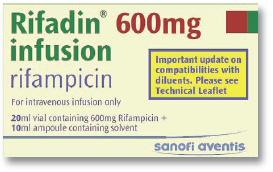Rifadin infusion (rifampicin): new solvent formulation and changes to compatible diluents
The solvent used in the preparation of Rifadin infusion has been reformulated. As a result, it can only be diluted with either dextrose 5% solution or sodium chloride 0·9% solution
Article date: April 2010
Rifadin 600 mg infusion (rifampicin) is used to treat various infections, including tuberculosis and leprosy. It is indicated for acutely ill patients who are unable to tolerate oral therapy. To prevent emergence of resistant strains, Rifadin should be used in combination with another appropriate antibiotic.
New solvent formulation
The solvent used in the preparation of Rifadin infusion has been reformulated. As a consequence the diluents which may be used to administer the medicine have changed.
An animal-derived product, polysorbate 81 (a surfactant), has been removed from the solvent supplied in the pack. This removal is to comply with European Commission requirements to minimise the risk of transmissible spongiform encephalopathy in medicinal products. For this reason, and in view of the limited data available, the diluents that can be used with the reconstituted powder have been restricted to dextrose 5% and normal saline.
The new formulation is expected to be available in April 2010. The marketing authorisation holder is taking steps to minimise the amount of time that the two formulations are in the supply chain concurrently. Healthcare professionals should use all existing stock before introducing the reformulated product.
The carton has been revised to help identify the reformulated product. It is clearly marked:
Important update on incompatibilities. Please see technical leaflet”.

Image of Rifadin infusion 600mg packaging.
A letter announcing the reformulation of Rifadin infusion was sent to healthcare professionals in March 2010.
Advice for healthcare professionals:
- rifadin infusion has been reformulated.
- new formulation can only be diluted with either dextrose 5% solution or sodium chloride 0·9% solution
- if you are in doubt about which formulation of Rifadin is in use, contact a hospital pharmacist before reconstitution or administration
See also summary of product characteristics for Rifadin infusion.
Article citation: Drug Safety Update April 2010, vol 3 issue 9: 9.